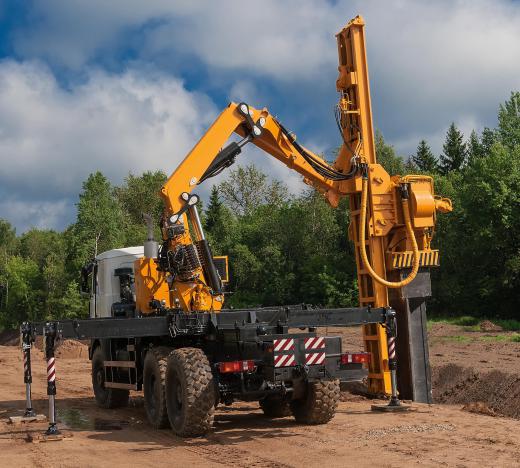Hydraulic hammers are the modern descendants of pile drivers. Pile drivers are mechanical devices used to stake piles into the ground to lay the foundation for buildings. The advent of diesel, hydraulics, and pneumatics helped deliver the force needed to drive piles into the ground and accomplish larger construction projects.
Hydraulic devices like the hydraulic hammer are based upon the theories of fluid mechanics and the work of Blaise Pascal and Daniel Bernoulli. A hydraulic system consists of a liquid, pump, pipes, motor, and output device. Hydraulics provide motive power to activate machinery by converting pressure exerted on a confined liquid medium into mechanical output. Pressure that is exerted on the enclosed, incompressible liquid is transferred equally in all directions and areas of the hydraulic system and is transmitted undiminished to the output device, which in this case is the hammer.

According to Pascal's law (P = F/A), applying a small force (F) to a small piston in a small area (A) creates a mechanical advantage when the resultant, constant pressure (P) is redirected through pipes to a larger area, producing a larger force able to move a larger piston. This concept is illustrated in the example below:
Pascal's law: P = F/A
If F1 = 2 lbs (1 kg), A1 = 1 in2 (6 cm2)
P = F1/A1 = 2 lbs/in2 (0.1 kg/cm2)
If F2 = x, A2 = 1000 in2 (6452 cm2)
F1/A1 = P = F2/A2
F1/A1 = F2/A2
2 lbs/in2 = x/1000 in2
x = (2 lbs/in2)(1000 in2) = 2000 lbs (907 kg) = F2
Essentially, this boils down to a significant increase in power: what starts out as 2 lbs (1 kg) of force ends up being 2000 lbs (907 kg) when the area is increased.

Hydraulic hammers have versatile applications in the construction, demolition, metal forging, quarry, and piling industries. As a pile driving device, hydraulic hammers drive piles into the soil by traveling in cycles of forward and reverse directions. The travel of the hammer stops while the digging tool is raised and allowed to free fall. Once it impacts the surface, the hydraulic hammer resumes travel to break up the surface. The force of the impact is regulated by factors such as ram weight, ram stroke, operating pressure, flow rate, hammer weight and dimensions, energy output, and dimensions of the guide pipe and guide claw.

Hydraulic hammers can be mounted on the end of a movable boom and be used for breaking rocks and concrete. They can be powered by a dedicated diesel engine or off the extractor's own diesel engine if mounted as a boom attachment. There are various, interchangeable hammer bits available, such as asphalt cutter, moil point, sheet driver, chisel point, tamper, pile driver, or blunt that can be outfitted to customize device function.
Hydraulic hammers are more environmentally friendly than other hammers because they generate less noise and pollutants. They are preferred in areas sensitive to vibration and noise since the use of vibratory hammers may otherwise disrupt the stability of existing structures or audibly disturb communities.
